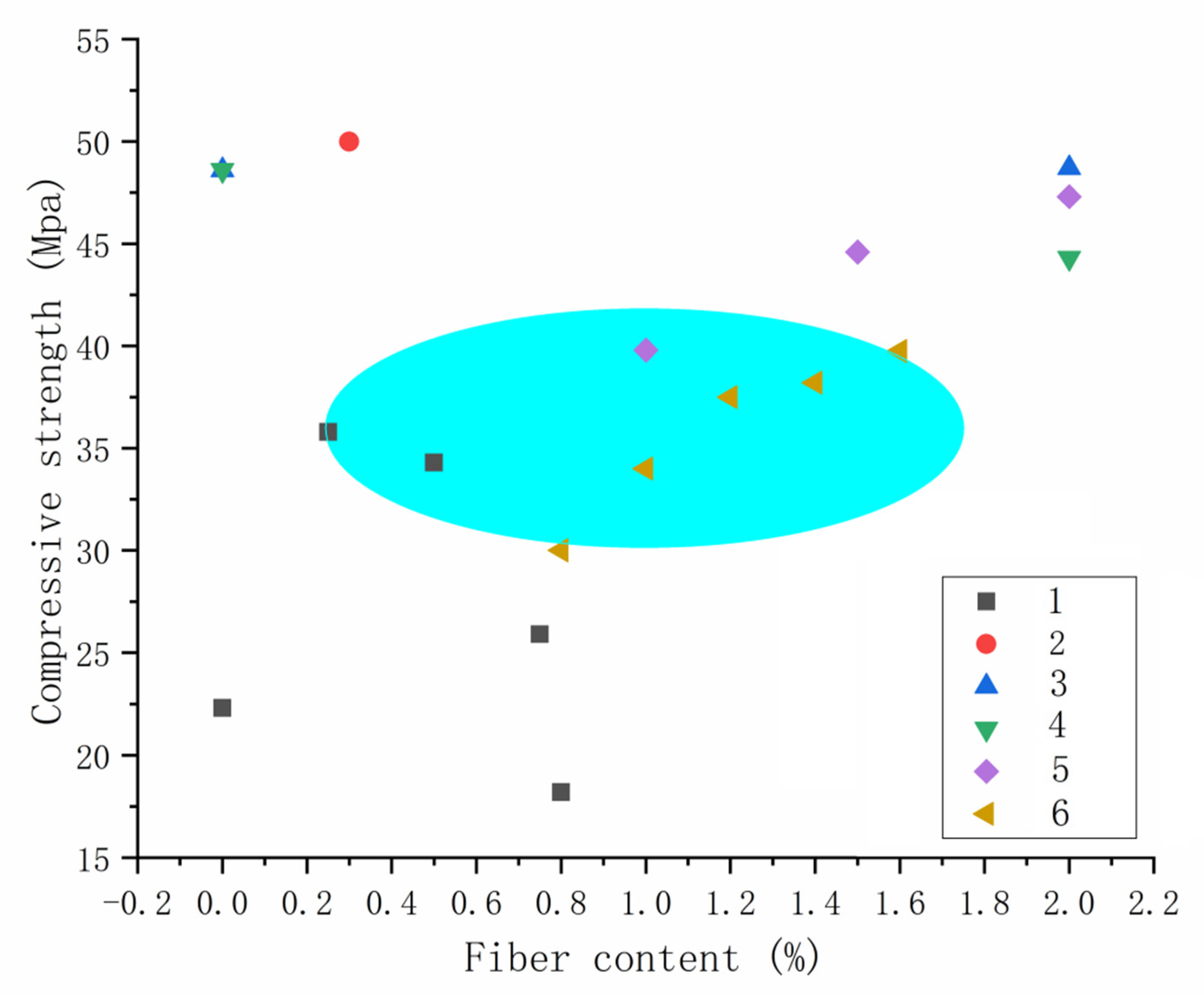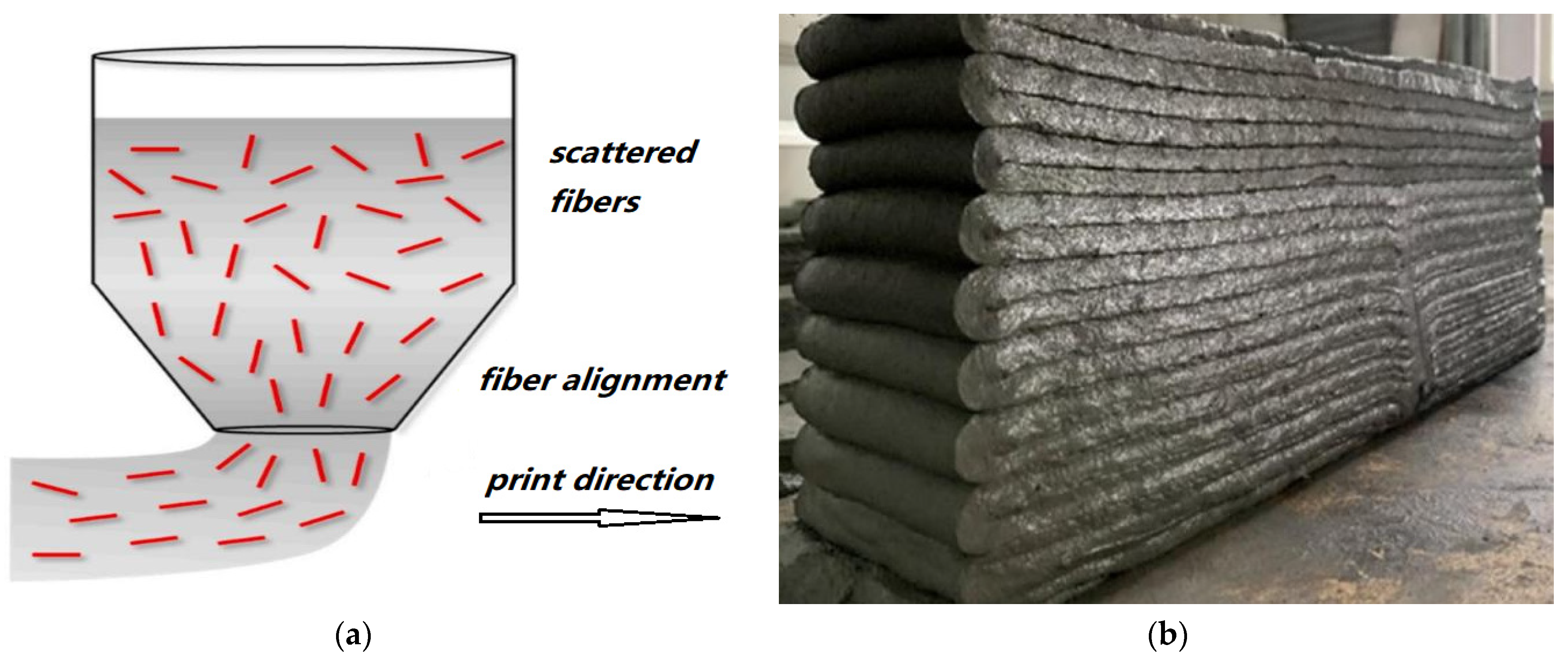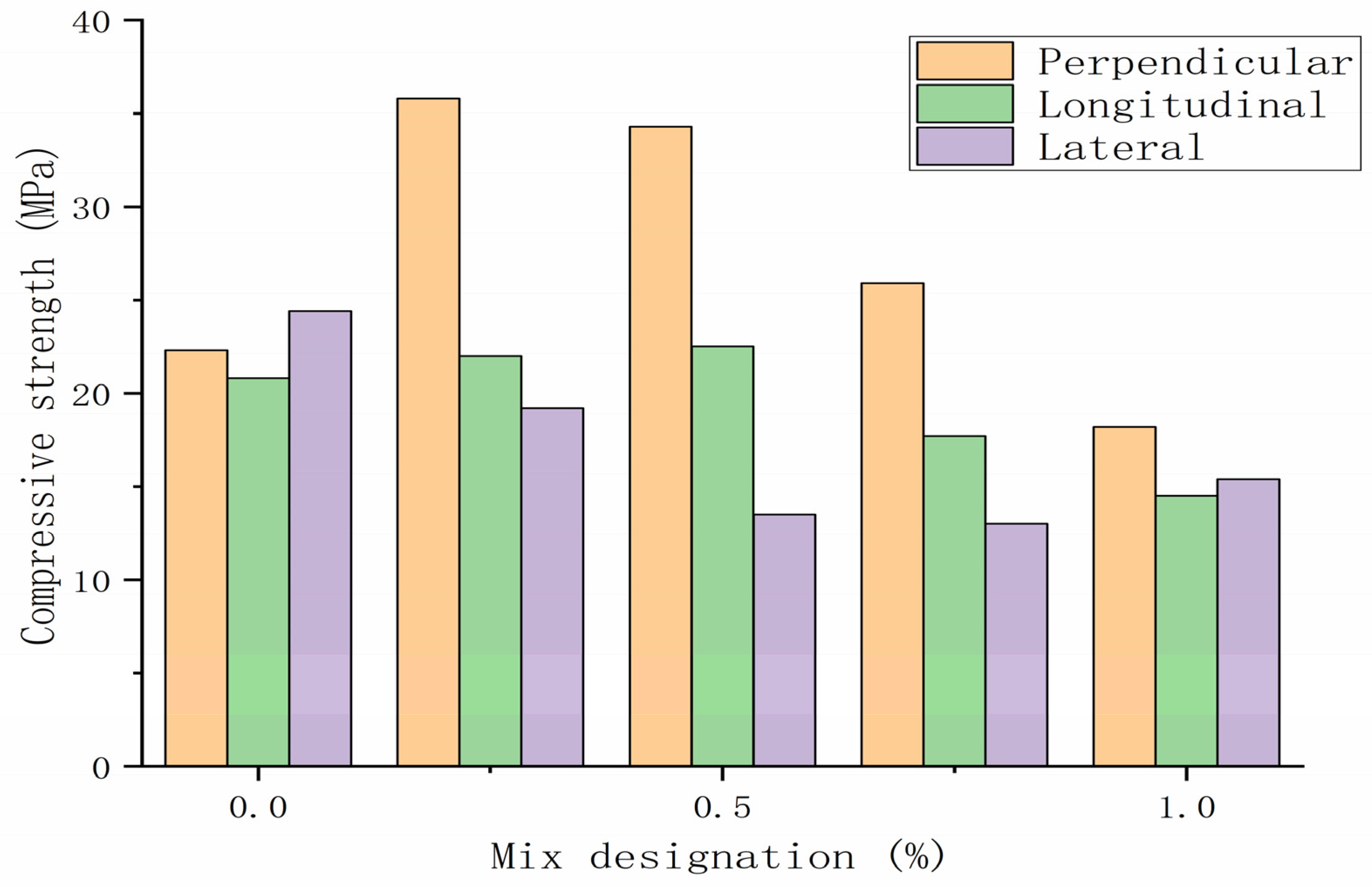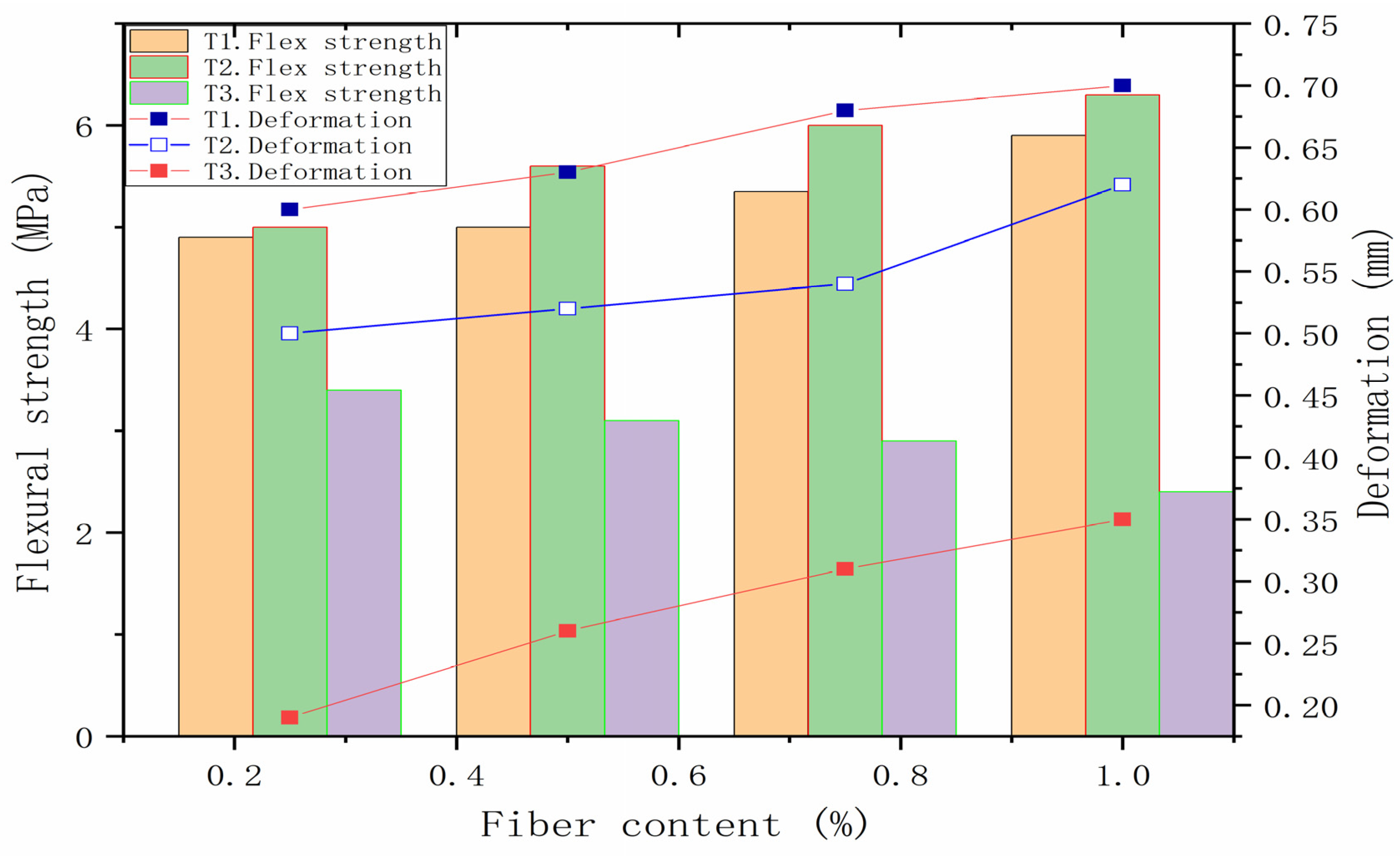Properties of 3D-Printed Polymer Fiber-Reinforced Mortars: A Review
Abstract
:1. Introduction
2. Polymer Fibers
3. Effect of Fiber on 3DPM Workability
3.1. Influence of the PE Fiber
3.2. Influence of PP Fiber
3.3. Influence of PVA Fiber
4. Effect of Fiber on Mechanical Properties of Mortars
4.1. Influence of Single Polymer Fiber
4.2. Influence of the Hybrid Polymer Fibers
5. Influence of Fiber on Interlaminar Bonding Strength
6. Conclusions and Outlooks
- Theoretical research on the interaction between polymer fibers and matrix of 3D mortar materials is insufficient. According to the characteristics of polymer fibers, the study of different types of polymer fiber theory support is insufficient, although the normal fiber reinforced mortar fiber spacing theory has been studied. 3DPM has its particularity, especially between the layers, and needs further research.
- There is a lack of engineering practice and application cases of polymer fiber reinforced 3DPMs, and the application of fibers in relevant experimental studies is relatively simple.
- The lack of chemical modification treatments of polymer fibers to improve its adhesion with matrix.
- The interaction mechanism of polymer fibers with nanomaterials, carboxymethyl cellulose and other additives needs further study.
- Replacing traditional steel fibers with polymer fibers can reduce the cost and improve the performance of 3DPMs. However, polymer fibers can easily pollute the environment during their production and use, which violates the concept of green environmental protection. It is imperative to replace polymer fibers and traditional fibers with natural plant fibers. Natural fibers are renewable and degradable, rich in resources, and can develop vigorous natural plant fiber-reinforced 3DPMs [89,90].
- Further study of the influence mechanism of anisotropy of 3DPMs, adjust the printing direction, fiber type and dosage according to the structural design, so that the anisotropy of mortar is consistent with the stress of the building.
- Hybrid fibers can improve the compressive strength, flexural strength and splitting strength, and significantly enhance the cracking resistance and toughness of 3DPMs. The hybrid fibers should be further combined with the characteristics of all kinds of fiber, using the principle of combination of different lengths, rigid and flexible, and actively promoting the use of hybrid fibers. The polymer fiber is soft and the steel fiber is hard, which can be mixed to avoid single fiber length and form a complete fiber network with reasonable fiber length gradation.
- The surface modification of polymer fibers can be combined with low temperature plasma, surface oxidation, surface grafting and silane coupling agent to improve the properties of fiber reinforced materials.
- The gap between each layer of mortar will affect the strength and durability of mortar. Through the rational use of fiber characteristics, the construction process conditions can be improved and the performance of printing equipment can be increased, so that the fiber penetrates the interface between mortar layers, takes part in the combination of mortar layers, and enhances the vertical and horizontal bonding of mortar layers.
- In the future, it is necessary to make full use of the effective combination of polymer fibers and nanomaterials to study the durability of 3DPMs. Using the flexibility of polymer fibers and large specific surface area of nanomaterials, multi-scale macro and micro fibers are formed in mortars, which further improve the workability, mechanical properties and durability of 3DPMs.
- Actively explore ways to improve the properties of 3DPMs. For example, it has been proven that it is possible to efficiently reinforce concrete beams by spatial 3D-printed polymer elements [91].
Author Contributions
Funding
Institutional Review Board Statement
Informed Consent Statement
Data Availability Statement
Conflicts of Interest
References
- Sathish Kumar, V.; Ganesan, N.; Indira, P.V. Shear Strength of Hybrid Fibre-Reinforced Ternary Blend Geopolymer Concrete Beams under Flexure. Materials 2021, 14, 6634. [Google Scholar] [CrossRef] [PubMed]
- Gábor, M.; Ágnes, S.; Sándor, N. Fiber reinforced geopolymer from synergetic utilization of fly ash and waste tire. J. Clean. Prod. 2018, 178, 429–440. [Google Scholar] [CrossRef]
- Rashad, A.M. The effect of polypropylene, polyvinyl-alcohol, carbon and glass fibres on geopolymers properties. Mater. Sci. Technol. 2019, 35, 127–146. [Google Scholar] [CrossRef]
- Zhang, P.; Han, X.; Zheng, Y.; Wan, J.; Hui, D. Effect of PVA fiber on mechanical properties of fly ash-based geopolymer concrete. Rev. Adv. Mater. Sci. 2021, 60, 418–437. [Google Scholar] [CrossRef]
- Guo, X.; Xiong, G. Resistance of fiber-reinforced fly ash-steel slag based geopolymer mortar to sulfate attack and drying-wetting cycles. Constr. Build. Mater. 2021, 269, 121326. [Google Scholar] [CrossRef]
- Shah, S.F.A.; Chen, B.; Oderji, S.Y.; Haque, M.A.; Ahmad, M.R. Comparative study on the effect of fiber type and content on the performance of one-part alkali-activated mortar. Constr. Build. Mater. 2020, 243, 118221. [Google Scholar] [CrossRef]
- Sainz-Aja, J.A.; Sanchez, M.; Gonzalez, L.; Tamayo, P.; Garcia del Angel, G.; Aghajanian, A.; Diego, S.; Thomas, C. Recycled Polyethylene Fibres for Structural Concrete. Appl. Sci. 2022, 12, 2867. [Google Scholar] [CrossRef]
- Liu, J.; Lv, C. Research progress on durability of cellulose fiber-reinforced cement-based composites. Int. J. Polym. Sci. 2021, 2021, 1014531. [Google Scholar] [CrossRef]
- Liu, J.; Lv, C. Durability of Cellulosic-Fiber-Reinforced Geopolymers: A Review. Molecules 2022, 27, 796. [Google Scholar] [CrossRef]
- Ogura, H.; Nerella, V.N.; Mechtcherine, V. Developing and Testing of Strain-Hardening Cement-Based Composites (SHCC) in the Context of 3D-Printing. Materials 2018, 11, 1375. [Google Scholar] [CrossRef] [Green Version]
- Yalçınkaya, Ç. Influence of Hydroxypropyl Methylcellulose Dosage on the Mechanical Properties of 3D Printable Mortars with and without Fiber Reinforcement. Buildings 2022, 12, 360. [Google Scholar] [CrossRef]
- Bohuchval, M.; Sonebi, M.; Amziane, S.; Perrot, A. Effect of metakaolin, and natural fibres on rheological properties of 3D printing concrete. Proc. Inst. Civ. Eng.-Constr. Mater. 2020, 19, 1–34. [Google Scholar]
- Paul, S.C.; Van Zijl, G.P.A.G.; Tan, M.J.; Gibson, I.; Campbell, R.I.; Campbell, R.I. A review of 3D concrete printing systems and materials properties: Current status and future research prospects. Rapid Prototyp. J. 2018, 24, 784–798. [Google Scholar] [CrossRef] [Green Version]
- Wu, Z.; Memari, A.M.; Duarte, J.P. State of the Art Review of Reinforcement Strategies and Technologies for 3D Printing of Concrete. Energies 2022, 15, 360. [Google Scholar] [CrossRef]
- Kaszyńska, M.; Skibicki, S.; Hoffmann, M. 3D Concrete Printing for Sustainable Construction. Energies 2020, 13, 6351. [Google Scholar] [CrossRef]
- Xia, M.; Sanjayan, J. Method of formulating geopolymer for 3D printing for construction applications. Mater. Design 2016, 110, 382–390. [Google Scholar] [CrossRef]
- Hoffmann, M.; Skibicki, S.; Pankratow, P.; Zieliński, A.; Pajor, M.; Techman, M. Automation in the Construction of a 3D-Printed Concrete Wall with the Use of a Lintel Gripper. Materials 2020, 13, 1800. [Google Scholar] [CrossRef] [Green Version]
- Hager, I.; Golonka, A.; Putanowicz, R. 3D Printing of Buildings and Building Components as the Future of Sustainable Construction? Procedia Eng. 2016, 151, 292–299. [Google Scholar] [CrossRef] [Green Version]
- Souza, M.T.; Ferreira, I.M.; Guzi, M.E. 3D printed concrete for large-scale buildings: An overview of rheology, printing parameters, chemical admixtures, reinforcements, and economic and environmental prospects. J. Build. Eng. 2020, 32, 101833. [Google Scholar] [CrossRef]
- Xia, M.; Nematollahi, B.; Sanjayan, J. Printability, accuracy and strength of geopolymer made using powder-based 3D printing for construction applications. Automat. Constr. 2019, 101, 179–189. [Google Scholar] [CrossRef]
- Long, W.; Tao, J.; Lin, C. Rheology and buildability of sustainable cement-based composites containing micro-crystalline cellulose for 3D-printing. J. Clean. Prod. 2019, 239, 118054. [Google Scholar] [CrossRef]
- Nerella, V.N.; Näther, M.; Iqbal, A.; Butlera, M.; Mechtcherinea, V. Inline quantification of extrudability of cementitious materials for digital construction. Cem. Concr. Comp. 2018, 95, 260–270. [Google Scholar] [CrossRef]
- Ma, G.; Wang, L.; Ju, Y. State-of-the-art of 3D printing technology of cementitious material—An emerging technique for construction. Sci. China Technol. Sci. 2018, 61, 475–495. [Google Scholar] [CrossRef]
- Le, T.T.; Austin, S.A.; Lim, S.; Buswel, R.A.; Gibb, A.G.F.; Thorpe, T. Mix design and fresh properties for high-performance printing concrete. Mater. Struct. 2012, 45, 1221–1232. [Google Scholar] [CrossRef] [Green Version]
- Paul, S.C.; Tay, Y.W.D.; Panda, B.; Tan, M.J. Fresh and hardened properties of 3D printable cementitious materials for building and construction. Arch. Civ. Mech. Eng. 2018, 18, 311–319. [Google Scholar] [CrossRef]
- Zhu, B.; Pan, J.; Zhou, Z.; Zhang, Y. Advances in Large-scale Three Dimensional Printing Technology Applied in Construction Industry. Mater. Rev. 2018, 32, 4150–4159. [Google Scholar] [CrossRef]
- Korniejenko, K.; Łach, M.; Chou, S.Y.; Lin, W.T.; Mikuła, J.; Mierzwi’nski, D.; Cheng, A.; Hebda, M. A Comparative Study of Mechanical Properties of Fly Ash-Based Geopolymer Made by Casted and 3D Printing Methods. IOP Conf. Ser. Mater. Sci. Eng. 2019, 660, 012005. [Google Scholar] [CrossRef] [Green Version]
- Al-Qutaifi, S.; Nazari, A.; Bagheri, A. Mechanical properties of layered geopolymer structures applicable in concrete 3D-printing. Constr. Build. Mater. 2018, 176, 690–699. [Google Scholar] [CrossRef]
- Marczyk, J.; Ziejewska, C.; Gądek, S.; Korniejenko, K.; Łach, M.; Góra, M.; Kurek, I.; Doğan-Sağlamtimur, N.; Hebda, M.; Szechyńska-Hebda, M. Hybrid Materials Based on Fly Ash, Metakaolin, and Cement for 3D Printing. Materials 2021, 14, 6874. [Google Scholar] [CrossRef]
- Arunothayan, A.R.; Nematollahi, B.; Ranade, R.; Bong, S.H.; Sanjayan, J.G.; Khayat, K.H. Fiber orientation effects on ultra-high performance concrete formed by 3D printing. Cem. Concr. Res. 2021, 143, 106384. [Google Scholar] [CrossRef]
- Korniejenko, K.; Łach, M.; Chou, S.Y.; Lin, W.T.; Cheng, A.; Hebdowska-Krupa, M.; Gądek, S.; Mikuła, J. Mechanical Properties of Short Fiber-Reinforced Geopolymers Made by Casted and 3D Printing Methods: A Comparative Study. Materials 2020, 13, 579. [Google Scholar] [CrossRef] [Green Version]
- Hambach, M.; Rutzen, M.; Volkmer, D. Properties of 3D-printed fiber-reinforced Portland cement paste. Cem. Concr. Comp. 2017, 79, 62–70. [Google Scholar] [CrossRef]
- Panda, B.; Paul, S.; Tan, M. Anisotropic mechanical performance of 3D printed fiber reinforced sustainable construction material. Mater. Lett. 2017, 209, 146–149. [Google Scholar] [CrossRef]
- Cao, M.; Xu, L.; Zhang, C. Review on Micromechanical Design, Performance and Development Tendency of Engineered Cementitious Composite. J. Chin. Ceram. Soc. 2015, 43, 632–642. [Google Scholar] [CrossRef]
- Panda, B.; Unluer, C.; Tan, M.J. Investigation of the rheology and strength of geopolymer mixtures for extrusion-based 3D printing. Cem. Concr. Comp. 2018, 94, 307–314. [Google Scholar] [CrossRef]
- Yang, E.H.; Li, V.C. Strain-hardening fiber cement optimization and component tailoring by means of a micromec hanical model. Constr. Build. Mater. 2010, 24, 130–139. [Google Scholar] [CrossRef]
- Panda, B.; Paul, S.C.; Hui, L.J.; Tay, Y.W.D.; Tan, M.J. Additive manufacturing of gerpolymer for sustainable built environment. J. Clean. Prod. 2017, 167, 281–288. [Google Scholar] [CrossRef]
- Yu, K.; Yu, J.; Dai, J.; Lu, Z.; Shahd, S.P. Development of ultra-high performance engineered cementitious composites using polyethylene (PE) fibers. Constr. Build. Mater. 2018, 158, 217–227. [Google Scholar] [CrossRef]
- Christ, S.; Schnabel, M.; Vorndran, E.; Groll, J.; Gbureck, U. Fiber reinforcement during 3D printing. Mater. Lett. 2015, 139, 165–168. [Google Scholar] [CrossRef]
- Li, Z.; Souza, L.R.d.; Litina, C.; Markaki, A.E.; Al-Tabbaa, A. Feasibility of Using 3D Printed Polyvinyl Alcohol (PVA) for Creating Self-Healing Vascular Tunnels in Cement System. Materials 2019, 12, 3872. [Google Scholar] [CrossRef] [Green Version]
- Nematollahi, B.; Vijay, P.; Sanjayan, J.; Nazari, A.; Xia, M.; Naidu Nerella, V.; Mechtcherine, V. Effect of Polypropylene Fibre Addition on Properties of Geopolymers Made by 3D Printing for Digital Construction. Materials 2018, 11, 2352. [Google Scholar] [CrossRef] [Green Version]
- Nematollahi, B.; Xia, M.; Sanjayan, J. Effect of Type of Fiber on Inter-Layer Bond and Flexural Strengths of Extrusion-Based 3D Printed Geopolymer. Mater. Sci. Forum 2018, 939, 155–162. [Google Scholar] [CrossRef]
- Nematollahi, B.; Sanjayan, J.; Qiu, J.; Yang, E.-H. High ductile behavior of a polyethylene fiber-reinforced one-part geopolymer composite: A micromechanics-based investigation. Arch. Civ. Mech. Eng. 2017, 17, 555–563. [Google Scholar] [CrossRef]
- Ye, J.; Cui, C.; Yu, J.; Yu, K.; Dong, F. Effect of polyethylene fiber content on workability and mechanical-anisotropic properties of 3D printed ultra-high ductile concrete. Constr. Build. Mater. 2021, 281, 122586. [Google Scholar] [CrossRef]
- Wang, Q.; Gao, C. Study on the Application of PVA Fiber in 3D Printing Concrete. Low Temp. Architect. Technol. 2019, 41, 3–6. [Google Scholar] [CrossRef]
- Zhang, T.; Lin, X.; Chen, W.; Huo, L.; Li, G.; Ji, W. Performance and Application of Ordinary Portland Cement-based Mortar for 3D Printing. J. Chin. Ceram. Soc. 2019, 47, 1629–1634. [Google Scholar] [CrossRef]
- Sun, X.; Zhou, J.; Wang, Q.; Shi, J.; Wang, H. PVA fibre reinforced high-strength cementitious composite for 3D printing: Mechanical properties and durability. Addit. Manuf. 2022, 49, 102500. [Google Scholar] [CrossRef]
- Ma, G.; Li, Z.; Wang, L. Printable properties of cementitious material containing copper tailings for extrusion based 3D printing. Constr. Build. Mater. 2018, 162, 613–627. [Google Scholar] [CrossRef]
- Malaszkiewicz, D. Influence of polymer fibers on rheological properties of cement mortars. Open Eng. 2017, 7, 228–236. [Google Scholar] [CrossRef]
- Le, T.T.; Austin, S.A.; Lim, S.; Buswe, R.A.; Law, R.; Gibb, A.G.F.; Thorpe, T. Hardened properties of high-performance printing concrete. Cement Concrete Res. 2012, 42, 558–566. [Google Scholar] [CrossRef] [Green Version]
- Rashedi, A.; Marzouki, R.; Raza, A.; Ali, K.; Olaiya, N.G.; Kalimuthu, M. Glass FRP-Reinforced Geopolymer Based Columns Comprising Hybrid Fibres: Testing and FEA Modelling. Polymers 2022, 14, 324. [Google Scholar] [CrossRef] [PubMed]
- Xu, W. The World’s Largest 3D-printed Concrete Bridge. Archit. Technol. 2019, 25, 6–9. [Google Scholar] [CrossRef]
- Xiao, S.; Cai, Y.; Guo, Y.; Lin, J.; Liu, G.; Lan, X.; Song, Y. Experimental Study on Axial Compressive Performance of Polyvinyl Alcohol Fibers Reinforced Fly Ash—Slag Geopolymer Composites. Polymers 2022, 14, 142. [Google Scholar] [CrossRef]
- Tosun-Felekoglu, K.; Felekoglu, B. Effects of fibre hybridization on multiple cracking potential of cement-based composites under flexural loading. Constr. Build. Mater. 2013, 41, 15–20. [Google Scholar] [CrossRef]
- Lim, J.; Panda, B.; Pham, Q. Improving flexural characteristics of 3D printed geopolymer composites with improcess steel cable reinforcemen. Constr. Build. Mater. 2018, 178, 32–41. [Google Scholar] [CrossRef]
- Lim, S.; Buswell, R.A.; Le, T.T.; Austin, S.A.; Gibb, A.G.F.; Thorpe, T. Developments in construction-scale additive manufacturing processes. Automat. Constr. 2011, 21, 262–268. [Google Scholar] [CrossRef] [Green Version]
- Feng, P.; Meng, X.; Chen, J.; Ye, L. Mechanical properties of structures 3D printed with cementitious powders. Constr. Build. Mater. 2015, 93, 486–497. [Google Scholar] [CrossRef] [Green Version]
- Nerella, V.N.; Mechtcherine, V. Studying the Printability of Fresh Concrete for Formwork-Free Concrete Onsite 3D Printing Technology. 3D Concr. Print. Techol. 2019, 2019, 333–347. [Google Scholar] [CrossRef]
- Murcia, D.H.; Genedy, M.; Reda Taha, M.M. Examining the significance of infill printing pattern on the anisotropy of 3D printed concrete. Constr. Build. Mater. 2020, 262, 120559. [Google Scholar] [CrossRef]
- Liu, Z.; Wang, Z.; Wang, L. Interlayer Bond Strength of 3D Printing Cement Paste by Cross-Bonded Method. J. Chin. Ceram. Soc. 2019, 47, 648–652. [Google Scholar] [CrossRef]
- Hsie, M.; Tu, C.; Song, P.S. Mechanical properties of polypropylene hybrid fiber-reinforced concrete. Mater. Sci. Eng. 2008, 494, 153–157. [Google Scholar] [CrossRef]
- Wolfs, R.J.M.; Bos, F.P.; Salet, T.A.M. Hardened properties of 3D printed concrete: The influence of process parameters on interlayer adhesion. Cem. Concr. Res. 2019, 119, 132–140. [Google Scholar] [CrossRef]
- Sanjayan, J.G.; Nematollahi, B.; Xia, M.; Marchment, T. Effect of surface moisture on inter-layer strength of 3D printed concrete. Constr. Build. Mater. 2018, 172, 468–475. [Google Scholar] [CrossRef]
- Nerella, V.N.; Hempel, S.; Mechtcherine, V. Effects of layer-interface properties on mechanical performance of concrete elements produced by extrusion-based 3D-printing. Constr. Build. Mater. 2019, 205, 586–601. [Google Scholar] [CrossRef]
- Ma, G.; Salman, N.M.; Wang, L. A novel additive mortar leveraging internal curing for enhancing interlayer bonding of cementitious composite for 3D printing. Constr. Build. Mater. 2020, 244, 118305. [Google Scholar] [CrossRef]
- Wang, L.; Tian, Z.; Ma, G. Interlayer bonding improvement of 3D printed concrete with polymer modified mortar: Experiments and molecular dynamics studies. Cem. Concr. Comp. 2020, 110, 103571. [Google Scholar] [CrossRef]
- Marchment, T.; Sanjayan, J.; Xia, M. Method of enhancing interlayer bond strength in construction scale 3D printing with mortar by effective bond area amplification. Mater. Design 2019, 169, 107684. [Google Scholar] [CrossRef]
- Hosseini, E.; Zakertabrizi, M.; Korayem, A.H.; Xu, G. A novel method to enhance the interlayer bonding of 3D printing concrete: An experimental and computational investigation. Cem. Concr. Comp. 2019, 99, 112–119. [Google Scholar] [CrossRef]
- Vaganov, V.; Popov, M.; Korjakins, A.; Šahmenko, G. Effect of CNT on Microstructure and Minearological Composition of Lightweight Concrete with Granulated Foam Glass. Procedia Eng. 2017, 172, 1204–1211. [Google Scholar] [CrossRef]
- Jeevanagoudar, Y.V.; Krishna, R.H.; Gowda, R.; Preetham, R.; Prabhakara, R. Improved mechanical properties and piezoresistive sensitivity evaluation of MWCNTs reinforced cement mortars. Constr. Build. Mater. 2017, 144, 188–194. [Google Scholar] [CrossRef]
- Konsta-Gdoutos, M.S.; Danoglidis, P.A.; Falara, M.G.; Nitodas, S.F. Fresh and mechanical properties, and strain sensing of nanomodified cement mortars: The effects of MWCNT aspect ratio, density and functionalization. Cem. Concr. Comp. 2017, 82, 137–151. [Google Scholar] [CrossRef]
- Ghazizadeh, S.; Duffour, P.; Skipper, N.T.; Bai, Y. Understanding the behaviour of graphene oxide in Portland cement paste. Cem. Concr. Res. 2018, 111, 169–182. [Google Scholar] [CrossRef] [Green Version]
- Cao, M.; Zhang, H.; Zhang, C. Effect of graphene on mechanical properties and microstructure of cement paste. J. Harbin Inst. Technol. 2015, 47, 26–30. [Google Scholar] [CrossRef]
- Cao, M.; Xu, L.; Zhang, C. Rheological and mechanical properties of hybrid fiber reinforced cement mortar. Constr. Build. Mater. 2018, 171, 736–742. [Google Scholar] [CrossRef]
- Fan, L.; Wang, L.; Ma, G. Enhanced compressive performance of concrete via 3D-printing reinforcement. J. Zhejiang Univ.-Sci. A 2019, 20, 675–684. [Google Scholar] [CrossRef]
- Van Der Putten, J.; Deprez, M.; Cnudde, V.; De Schutter, G.; Van Tittelboom, K. Microstructural Characterization of 3D Printed Cementitious Materials. Materials 2019, 12, 2993. [Google Scholar] [CrossRef] [Green Version]
- Zhang, H.; Zhu, L.; Zhang, F.; Yang, M. Effect of Fiber Content and Alignment on the Mechanical Properties of 3D Printing Cementitious Composites. Materials 2021, 14, 2223. [Google Scholar] [CrossRef]
- Zhang, Y.; Zhang, Y.S.; Liu, G.; Yang, Y.; Wu, M.; Pang, B. Fresh properties of a novel 3D printing concrete ink. Constr. Build. Mater. 2018, 174, 263–271. [Google Scholar] [CrossRef]
- Bohuchval, M.; Sonebi, M.; Amziane, S.; Perrot, A. Effect of metakaolin and natural fibres on three-dimensional printing mortar. Proc. Inst. Civ. Eng.-Constr. Mater. 2021, 174, 115–128. [Google Scholar] [CrossRef]
- Bos, F.P.; Ahmed, Z.Y.; Wolfs, R.J.M.; Salet, T.A.M. 3D Printing Concrete with Reinforcement. In High Tech Concrete: Where Technology and Engineering Meet; Hordijk, D., Luković, M., Eds.; Springer: Cham, Switzerland, 2018. [Google Scholar] [CrossRef]
- Ma, G.; Wang, L. A critical review of preparation design and workability measurement of concrete material for largescale 3D printing. Front. Struct. Civ. Eng. 2018, 12, 282–400. [Google Scholar] [CrossRef]
- Asprone, D.; Auricchio, F.; Menna, C.; Mercuri, V. 3D printing of reinforced concrete elements: Technology and design approach. Constr. Build. Mater. 2018, 165, 218–231. [Google Scholar] [CrossRef]
- Bos, F.P.; Ahmed, Z.Y.; Jutinov, E.R.; Salet, T.A.M. Experimental Exploration of Metal Cable as Reinforcement in 3D Printed Concrete. Materials 2017, 10, 1314. [Google Scholar] [CrossRef] [Green Version]
- Buswell, R.A.; Leal De Silva, W.R.; Jones, S.Z.; Dirrenberger, J. 3D printing using concrete extrusion: A roadmap for research. Cem. Concr. Res. 2018, 112, 37–49. [Google Scholar] [CrossRef]
- Ardanuy, M.; Claramunt, J.; Filho, R.D.T. Cellulosic fiber reinforced cement-based composites: A review of recent research. Constr. Build. Mater. 2015, 79, 115–128. [Google Scholar] [CrossRef] [Green Version]
- Wei, J.; Ma, S.; Thomas, D.G. Correlation between hydration of cement and durability of natural fiber-reinforced cement composites. Corros. Sci. 2016, 106, 1–15. [Google Scholar] [CrossRef]
- Azlin, M.N.M.; Ilyas, R.A.; Zuhri, M.Y.M.; Sapuan, S.M.; Harussani, M.M.; Sharma, S.; Nordin, A.H.; Nurazzi, N.M.; Afiqah, A.N. 3D Printing and Shaping Polymers, Composites, and Nanocomposites: A Review. Polymers 2022, 14, 180. [Google Scholar] [CrossRef]
- Lesovik, V.; Fediuk, R.; Amran, M.; Alaskhanov, A.; Volodchenko, A.; Murali, G.; Uvarov, V.; Elistratkin, M. 3D-Printed Mortars with Combined Steel and Polypropylene Fibers. Fibers 2021, 9, 79. [Google Scholar] [CrossRef]
- Onuaguluchi, O.; Banthia, N. Plant-based natural fibre reinforced cement composites: A review. Cem. Concr. Compos. 2016, 68, 96–108. [Google Scholar] [CrossRef]
- Luhar, S.; Suntharalingam, T.; Navaratnam, S.; Luhar, I.; Thamboo, J.; Poologanathan, K.; Gatheeshgar, P. Sustainable and Renewable Bio-Based Natural Fibres and Its Application for 3D Printed Concrete: A Review. Sustainability 2020, 12, 10485. [Google Scholar] [CrossRef]
- Katzer, J.; Szatkiewicz, T. Effect of 3D Printed Spatial Reinforcement on Flexural Characteristics of Conventional Mortar. Materials 2020, 13, 3133. [Google Scholar] [CrossRef]





| Fiber | Diameter (µm) | Density (g·cm−3) | Tensile Strength (MPa) | Young’s Modulus (GPa) | Ultimate Elongation (%) |
|---|---|---|---|---|---|
| PE | 7–150 | 0.96 | 200–300 | 5–6 | 3–4 |
| PP | 20–70 | 0.91 | 300–700 | 3.5–11 | 15–25 |
| PVA | 1.30 | 1.30 | 600–2500 | 5–50 | 6–17 |
| PAN | 5–17 | 1.18 | 800–950 | 16–32 | 9–11 |
| AR | 10–12 | 1.442 | 500–3100 | 60–120 | 2.1–4.5 |
| Fiber Type | Fiber Length (mm) | Aspect Ratio | Fiber Content (%) * | Gelled Material | Admixture (%) * | Ref. |
|---|---|---|---|---|---|---|
| PP | 12.00 | 667 | 1.20 | OPC | 20 (FA); 10 (SF) | [24] |
| 11.20 | 1867 | 0.25–1.00 | GC | 100 (FA) | [41] | |
| 6.00 | 500 | 0.25 | GC | 100 (FA) | [42] | |
| PE | 12.00 | 1000 | 2.00 | GC | 50 (FA); 50 (Slag) | [43] |
| 12.00 | 480 | 1.00; 1.50; 2.00 | OPC | 17.99 (FA); 37.5 (SF); 8.69 (NR) | [44] | |
| PVA | 26.00 | 2167 | 0.25 | GC | 100 (FA) | [42] |
| 8.00 | 200 | 2.00 | GC | 50 (FA); 50 (Slag) | [43] | |
| 9.00 | 290 | 0.8–1.6 | OPC | 50 (GGBS); 17 (SF) | [45] | |
| 12.00 | 480 | 0.30 | GC | 11.12 (SAC) | [46] | |
| PBO | 11.20 | 933 | 0.25 | GC | 100 (FA) | [42] |
| Mix ID | Fly Ash | Activator | Fine Sand | Coarse Sand | PP Fiber | CMC | Expanded Diameter (mm) |
|---|---|---|---|---|---|---|---|
| PP0 | 1.0 | 0.467 | 1.135 | 0.365 | - | 0.040 | 147 |
| PP0.25 | 1.0 | 0.467 | 1.135 | 0.365 | 0.25 | 0.028 | 139 |
| PP0.5 | 1.0 | 0.467 | 1.135 | 0.365 | 0.50 | 0.023 | 138 |
| PP0.75 | 1.0 | 0.467 | 1.135 | 0.365 | 0.75 | 0.012 | 158 |
| PP1.00 | 1.0 | 0.467 | 1.135 | 0.365 | 1.00 | 0.004 | 134 |
Publisher’s Note: MDPI stays neutral with regard to jurisdictional claims in published maps and institutional affiliations. |
© 2022 by the authors. Licensee MDPI, Basel, Switzerland. This article is an open access article distributed under the terms and conditions of the Creative Commons Attribution (CC BY) license (https://creativecommons.org/licenses/by/4.0/).
Share and Cite
Liu, J.; Lv, C. Properties of 3D-Printed Polymer Fiber-Reinforced Mortars: A Review. Polymers 2022, 14, 1315. https://doi.org/10.3390/polym14071315
Liu J, Lv C. Properties of 3D-Printed Polymer Fiber-Reinforced Mortars: A Review. Polymers. 2022; 14(7):1315. https://doi.org/10.3390/polym14071315
Chicago/Turabian StyleLiu, Jie, and Chun Lv. 2022. "Properties of 3D-Printed Polymer Fiber-Reinforced Mortars: A Review" Polymers 14, no. 7: 1315. https://doi.org/10.3390/polym14071315
APA StyleLiu, J., & Lv, C. (2022). Properties of 3D-Printed Polymer Fiber-Reinforced Mortars: A Review. Polymers, 14(7), 1315. https://doi.org/10.3390/polym14071315






